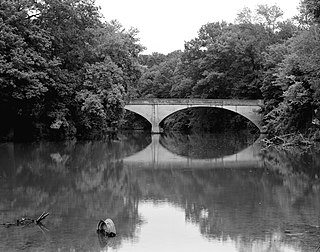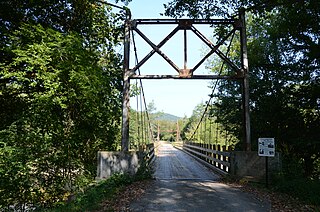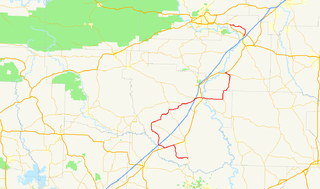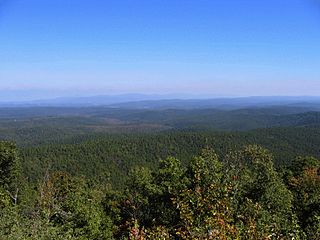U.S. Route 67 is a U.S. highway running from Presidio, Texas northeast to Sabula, Iowa. In the U.S. state of Arkansas, the route runs 279.15 miles (449.25 km) from the Texas border in Texarkana northeast to the Missouri border near Corning. The route passes through several cities and towns, including Hope, Benton, Little Rock, Jacksonville, Cabot, Beebe, Walnut Ridge, and Pocahontas.

Arkansas Highway 365 is a north–south state highway in Central Arkansas. The route of 69.31 miles (111.54 km) runs from US 65B/US 79B in Pine Bluff north through Little Rock to US 65B/AR 60 in Conway. The route is a redesignation of former U.S. Route 65, which has since been rerouted onto various Interstate highways through the area. Portions of Highway 365 in Jefferson County are former alignments of the Dollarway Road, which was the longest paved concrete road upon completion in 1913.

Highway 8 is an east–west state highway in Lower Arkansas. The route of 229.83 miles (369.88 km) runs from Oklahoma State Highway 63 (SH-63) at the Oklahoma state line east across the state to US Route 65 (US 65) south of Eudora.

The Dollarway Road is a historic road in Redfield, Arkansas that was built in 1913. It was listed on the National Register of Historic Places in 1974.

The Illinois River Bridge, also known as the Midway Bridge, is a historic concrete arch bridge near Siloam Springs, Arkansas. It is located in Ozark National Forest, about 6 miles (9.7 km) east of Siloam Springs, at the end of Chambers Springs Road south of United States Route 412. The bridge has two elliptical arch spans, each spanning 68 feet (21 m), with a total structure length of 139 feet (42 m). Built in 1922 by the Luten Bridge Company of Knoxville, Tennessee, it is one of a modest number of bridges of this once-popular and common type remaining in the state.

The Sumner–White Dipping Vat is a historic concrete cattle dipping vat in Ashley County, Arkansas. It is located about four miles northeast of the intersection of U.S. Highway 82 and County Road 69, half a mile in the woods northeast of the Sumner-White Hunt Club. The vat is a concrete structure about 27 feet (8.2 m) long, 4 feet (1.2 m) wide, and 7 feet (2.1 m) deep. A U-shaped concrete structure, built about the same time, stands about 2 feet (0.61 m) from the vat, near where cattle would have exited the vat. It was probably built c. 1915, when a statewide program was initiated for the eradication of Texas tick fever. The facilities were likely used until the program came to an end in 1943.

The Gregory Dipping Vat is a historic cattle dipping facility at 122 Rogers Street on the outskirts of Lake Village, Arkansas. The vat is a concrete structure 27 feet (8.2 m) long, 4 feet (1.2 m) wide, and 7 feet (2.1 m) deep. It is located on a grassy lane off Rogers Road, in a wooded area not far from Bayou Macon, whose waters were used to fill it. The vat was built c. 1930 as part of a statewide program to eradicate Texas tick fever, which was at the time a serious problem affecting the area's cattle farmers. After the program was ended in 1943, the vat became a play area for local youth. It remains in good condition as a reminder of the economically important tick eradication program.

The Illinois River Bridge at Phillips Ford is a historic bridge in rural northern Washington County, Arkansas. It is a double-span closed-spandrel concrete arch bridge built in 1928 by the Luten Bridge Company, and it carries County Road 848 across the Illinois River in the Ozark National Forest south of U.S. Route 412 (US 412). The bridge's arches each span 81 feet (25 m), and the total structure length is 168 feet (51 m). The bridge uses Luten's patented method of reducing material in the bridge by the addition of metal rings to the spandrel walls.

The Bard Springs Picnic Shelter is a historic recreational support facility in Ouachita National Forest. It is located at the Bard Springs recreation site, southeast of Mena and north of Athens in Polk County, off County Road 82 and Forest Road 106 on the banks of Blaylock Creek. It is a square open-air structure, with four rustic stone columns supporting a gabled roof. The foundation is stone, with the support columns set in concrete blocks. It was built in 1936 by a crew of the Civilian Conservation Corps, and is one of four surviving CCC structures in the immediate area.

Cold Spring is a small fresh-water spring in Ouachita National Forest, east of Waldron, Arkansas in Scott County. It is located on the south side of County Road 93, a short way south of where the road crosses Sugar Creek. The spring is protected by a stone and concrete structure erected by a crew of the Civilian Conservation Corps in c. 1936 to prevent contamination of the spring and erosion of the surrounding hillside. Near the spring are two open-air concrete water holding areas, from which a stone culvert channels the water to Sugar Creek. These CCC-built structures were listed on the National Register of Historic Places in 1993.

The Dooley Dipping Vat is a historic former cattle dipping facility in Ouachita National Forest, southeast of Boles, Arkansas. It is located on a high bank of Countiss Creek east of County Road 925. It is a U-shaped concrete structure, oriented north-south with a concrete pad at southern (exit) end. The vat varies in depth between 1 and 2 meters, and is 48 inches wide at the entrance and 36 inches wide at the exit. It was built about 1920 as part of a state program to eradicate Texas tick fever from the state's cattle. The vat's name derives from James Dooley, who homesteaded a farm in the area.

The CCC Company 741 Powder Magazine Historic District encompasses two structures built by Camp 741 of the Civilian Conservation Corps c. 1936. The camp, the first established in Arkansas, used these structures to store explosive materials used in road and bridge construction projects. The two structures have concrete bases and tops, and have walls of cut fieldstone and concrete. The main magazine is 8 by 16 feet, and the blasting cap storage building is about 10 by 10 feet. The main magazine is located a short way north of Forest Road 177M in Ouachita National Forest; the blasting cap storage building is about 113 metres (371 ft) to its northwest.

The Cogburn Dipping Vat is a historic former cattle dipping facility in Ouachita National Forest, west of Black Spring, Arkansas. It is located about 19 metres (62 ft) west of Forest Road 73 and south of a perennial stream. It is a U-shaped concrete structure, with a distinctive curved shape that matches the contours of the terrain, with a concrete pad at one end. The total length of the structure is about 13 metres (43 ft). It was built between 1930 and 1940 as part of a state program to eradicate Texas tick fever from the state's cattle. The vat's name derives from the Cogburn, who homesteaded a farm in the area, and probably built the vat to serve their needs and those of other nearby farmers.

The Guinn Dipping Vat is a historic former cattle dipping facility in Ouachita National Forest, northwest of Mount Ida, Arkansas in the ghost town of Mauldin. It is located south of Forest Road 37 west of United States Route 270. It is a U-shaped concrete structure with a concrete and stone drip pad at one end, and is covered with boards. The vat was built c. 1940 by Mack Guinn to serve the local farm population in its efforts to eradicate Texas tick fever.

The Sylamore Creek Bridge is a historic bridge in east central Stone County, Arkansas, just south of the Ozark-St. Francis National Forest. It carries County Road 283 across Sylamore Creek, a short way west of Arkansas Highway 9 and north of the Holiday Mountain Resort in Allison. It is a wire-cable suspension bridge, with steel towers mounted on concrete piers supporting four main cables that are anchored into concrete abutments. The bridge is 202 feet (62 m) long, with a deck width of 19 feet 6 inches (5.94 m) and a clearance height of 11 feet (3.4 m). Built in 1945, it is one of three known wire-cable bridges in the state.

The Jim Wright Farmstead Historic District encompasses a well-preserved early 20th-century farmstead in rural White County, Arkansas. The property is located on the south side of Arkansas Highway 258, east of its junction with Arkansas Highway 323, northwest of Bald Knob. It includes a Craftsman style single-story wood frame farmhouse, with a wraparound porch supported by simple Doric columns, a simple wood-frame garage, and a single-story wood frame house for tenant workers. It also includes remnants of the farmstead's first house and barn, silo, and a cattle dipping vat. This land was homesteaded in 1860 by the parents of Jim Wright, who is credited with construction of most of the farmstead's surviving features, which were built between 1924 and 1940.

The CCC Company 947 Powder Magazine is a historic powder magazine in the eastern part of Ouachita National Forest. It is located in southern Yell County, about 200 yards (180 m) down a slope north of a ridge running parallel to Forest Road 71. The structure is made of stone and concrete, and is 6 feet (1.8 m) square and 5 feet (1.5 m) high, with a flat concrete roof and floor. The entrance is on the southeast side. The building was erected about 1933 by a crew of the Civilian Conservation Corps, and was used to store explosive materials used in the construction of roads and bridges in the area.

The Pottsville Dipping Vat is a historic cattle processing structure in Rankin Park, on East Ash Street in Pottsville, Arkansas. It consists of a U-shaped concrete structure, with an extended base at one end. The structure has a total length of 42 feet (13 m), and the vat is 2 feet (0.61 m) wide and 7 feet (2.1 m) deep. It was probably built about 1915, not long after the state began a program to eradicate Texas cattle fever from its livestock.

The Liberty Schoolhouse, also known as the Mt. Grove School, is a historic schoolhouse in a remote part of Ozark-St. Francis National Forest in Logan County, Arkansas. It is east of Corley, Arkansas, near the junction of Valentine Spring and Copper Spring Roads. It is a single-story vernacular wood-frame structure, with a gabled roof, weatherboard siding, and a foundation of concrete block piers. It was built in 1897, and was used by the community as both a school and church. It served as a school until 1944, and also hosted civic meetings and social events.

Highway 51 is a designation for two north–south state highways in Southwest Arkansas. One route of 53.37 miles (85.89 km) begins Highway 53 near Whelen Springs and runs north to US Highway 67 in Donaldson. A second route of 7.92 miles (12.75 km) runs parallel to US 270 northwest of Malvern. Both routes are maintained by the Arkansas Department of Transportation (ArDOT).
















